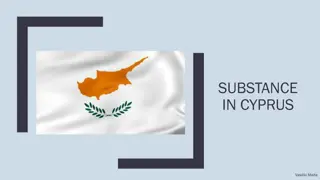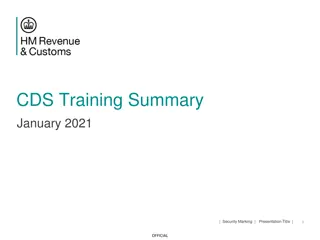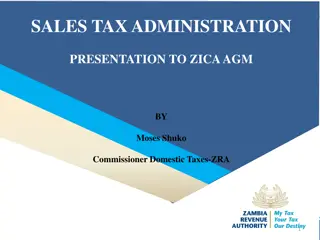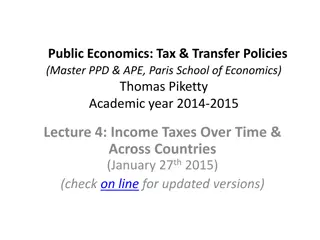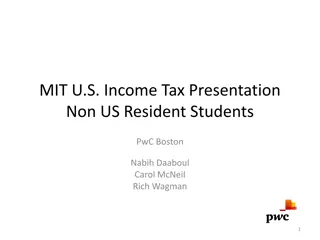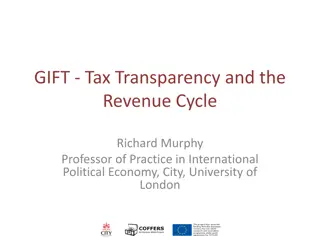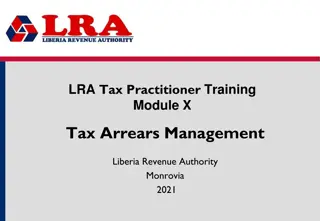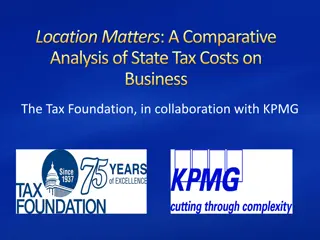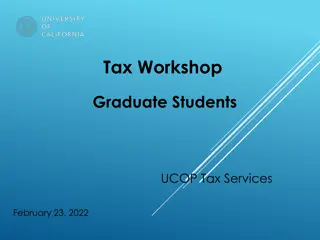Tax Lines Equivalents in CDS
These slides address questions from Software Developers regarding Tax Lines, covering the relationship between Tax Lines in CHIEF and their equivalent data elements in CDS. Key updates and examples are provided to facilitate understanding of logical grouping and calculations. The presentation emphasizes practical implementation for manual duty calculation and declaration submission.
Download Presentation

Please find below an Image/Link to download the presentation.
The content on the website is provided AS IS for your information and personal use only. It may not be sold, licensed, or shared on other websites without obtaining consent from the author.If you encounter any issues during the download, it is possible that the publisher has removed the file from their server.
You are allowed to download the files provided on this website for personal or commercial use, subject to the condition that they are used lawfully. All files are the property of their respective owners.
The content on the website is provided AS IS for your information and personal use only. It may not be sold, licensed, or shared on other websites without obtaining consent from the author.
E N D
Presentation Transcript
Tax Lines Equivalents in CDS Version: v2.3 Date: 24/02/20 Authors: Nawras Alsaegh, Stuart Lewis
Purpose The purpose of these slides is to respond to a number of questions that have been raised by Software Developers relating to Tax Lines . Following an initial issue to the developer community, feedback has been taken into account in order to produce an updated version of this presentation. The presentation covers three main areas:- 1. Description of the relationship between Tax Lines in CHIEF and their equivalent data elements in CDS for both the automatic and manual calculations 2. Description of how these data elements are related, and how they can be logically grouped 3. Worked examples that demonstrate the logical grouping of calculation-related data Prepared by: HMRC (CDIO (C&IT) CDS) HMRC NL Standard | 24/01/2020 | 2
Key Updates since v1.6 Slide number Change Made 5 Removed mention of end-state requirements 10 Clarified default value used if D.E. 4/17 is not provided 10 Removed reference to future requirement for D.E. 4/8 11 Included HMRC position on current implementation vs. Tariff requirement and reference to appendix B Clarified that D.E. 4/4 is to be provided stand-alone without relating to D.E. 4/3 in the context of the automatic tax calculation Clarified that method of payment codes E and R both represent the same method of payment i.e. deferment Added a complex excise example for multiple measurement units 12 13, 14 19 23 Added Appendix B for HMRC position on future requirements Prepared by: HMRC (CDIO (C&IT) CDS) HMRC NL Standard | 24/01/2020 | 3
Tax Lines Representation in CHIEF In CHIEF, declarants would declare the tax types that they were expecting their goods to attract, and if this aligned with CHIEF s expectations, calculated amounts would be returned against those tax lines. If not, an error would be returned asking the declarant to correct their tax lines. Additional data such as a method of payment would have been required as part of the tax lines. Depending on the measures defined against the commodity code, a tax base may also have been required. Prepared by: HMRC (CDIO (C&IT) CDS) HMRC NL Standard | 24/01/2020 | 4
Tax Lines Equivalent in CDS Tax lines as a construct do not currently formally exist in CDS in the same way they were implemented in CHIEF, and are not required in order to drive the automatic calculation of customs debt. Tax Line element SAD EUCDM WCO XML Location Tax Type 47a D.E. 4/3 DutyTaxFee/TypeCode Tax Base 47b D.E. 4/4 DutyTaxFee/SpecificTaxBaseQuantity Tax Amount 47d D.E. 4/6 DutyTaxFee/Payment/PaymentAmount Method of Payment 47e D.E. 8/4 DutyTaxFee/Payment/MethodCode The data elements in the table above are present in CDS Declarations and Trader Notifications. The following slides in the presentation detail the scenarios on when and how these data elements are to be used for the purposes of manual duty calculation and declaration submission. N.B. The Tax Rate that was entered in SAD box 47c in CHIEF has now been superseded by the preference code in D.E. 4/17. Prepared by: HMRC (CDIO (C&IT) CDS) HMRC NL Standard | 24/01/2020 | 5
Manual calculation and C21s C21 Declarations allow the trader to enter the results of a manual calculation, if applicable, in order for the necessary tax revenues to be collected. Note: this is achieved automatically on a C21 declaration for all goods items without declaring the OVR01 AI code. For other declaration types, in scenarios where a manual calculation is required for a specific goods item (as per Appendix A or guidance in the UK Trade Tariff: Volume 3 for CDS), "OVR01" can be declared in D.E. 2/2 Additional Information Code to override the results of the automated calculation for that goods item. This overrides the calculation for all tax types for that goods item, but note that automatic calculation will still be performed for other goods items on the declaration unless OVR01 is also declared on those items. In both cases, tax line equivalent data can be supplied across as many DutyTaxFee objects as required to communicate the results of the manual calculation for that goods item. For example, if the manual calculation results in having to pay for two tax types A00 and B00, the amounts and related data need to be declared across two DutyTaxFee objects. Prepared by: HMRC (CDIO (C&IT) CDS) HMRC NL Standard | 24/01/2020 | 6
Automatic tax calculation For the automatic tax calculation, the DutyTaxFee object is also a vehicle to enter other calculation-related data that are independent of tax line data e.g. quota order ID, preference. This data is not always interrelated, and therefore can be provided in separate DutyTaxFee objects. Doing so introduces logical separation between data elements, which can simplify its entry in the declaration, as demonstrated in the next slide. Prepared by: HMRC (CDIO (C&IT) CDS) HMRC NL Standard | 24/01/2020 | 7
DutyTaxFee Data in the Declaration While DutyTaxFee data can technically be provided together, the following four groupings have been identified for the sake of simplicity (these are described in more detail in later slides): 1. 2. 3. 4. Standard DutyTaxFee object once per goods item Tax Type DutyTaxFee object once per expected tax type Measurement Unit DutyTaxFee object once per measurement unit Manual Calculation DutyTaxFee object once per manually calculated tax type The provision of the data will vary on the scenario, but the following types will be required: If utilising the automatic tax calculation, a combination of the first three types will be required an example is provided in Example 1 in the next slide If a manual calculation has been performed, multiple instances of the fourth type will be required an example of this is provided in Example 2. Prepared by: HMRC (CDIO (C&IT) CDS) HMRC NL Standard | 24/01/2020 | 8
Example 1: Automatic Tax Calculation claiming a preferential rate and including Tax Types 1) In this example, the trader would like to claim a preferential rate, and thus provides a preference value of 300 , but does not need to provide a quota order ID in the Standard DutyTaxFee object. 2) As the trader will be paying using their deferment account, a MOP code of E is provided against the two tax types that the trader expects to attract with their goods item across two Tax Type 'DutyTaxFee' objects. 3) An additional measurement unit will be required to perform the automatic tax calculation, and this is provided within a Measurement Unit DutyTaxFee object. <DutyTaxFee> <DutyRegimeCode>300</DutyRegimeCode><!--D.E. 4/17--> </DutyTaxFee> <DutyTaxFee> <TypeCode>A00</TypeCode><!--D.E. 4/3--> <Payment> <MethodCode>E</MethodCode><!--D.E. 4/8--> </Payment> </DutyTaxFee> <DutyTaxFee> <TypeCode>B00</TypeCode><!--D.E. 4/3--> <Payment> <MethodCode>E</MethodCode><!--D.E. 4/8--> </Payment> </DutyTaxFee> <DutyTaxFee> <SpecificTaxBaseQuantity unitCode= DTN#E">30000.00</SpecificTaxBaseQuantity><!--D.E. 4/4--> </DutyTaxFee> As per previous guidance, this data can still be provided together without logical separation, but this may introduce unnecessary complexity for the purposes of mapping trader-declared data into the WCO Declaration. All examples provided in this presentation utilise the grouped approach described in further detail in the next slides. Standard DutyTaxFee Tax Type DutyTaxFee Measurement DutyTaxFee Prepared by: HMRC (CDIO (C&IT) CDS) HMRC NL Standard | 24/01/2020 | 9
Standard DutyTaxFee This type of DutyTaxFee is to be included if any of the following data, which is required at most once per goods item, has been declared: D.E. 4/17 Preference If it is not mandated in a given scenario, and it has not been provided, the system will assume a preference code of 100 for the purposes of the automatic tax calculation D.E. 8/1 Quota Order ID D.E. 4/8 Method of Payment While D.E. 4/8 can be declared against D.E. 4/3 within a Tax Type DutyTaxFee object (as described in the next slide), it can be provided in the Standard DutyTaxFee object, if the trader has no tax types to declare. If a Standard DutyTaxFee is required, this will need to be included as the first DutyTaxFee object within the goods item Prepared by: HMRC (CDIO (C&IT) CDS) HMRC NL Standard | 24/01/2020 | 10
Tax Type DutyTaxFee This type of DutyTaxFee is to be included if any of the following data, which is required once per expected tax type, has been declared: D.E. 4/3 Tax Type D.E. 4/8 Method of Payment This is not always required e.g. if claiming relief. For full details, refer to the dataset completion requirements in the UK Trade Tariff: Volume 3 for CDS The Tariff requires the completion of a tax type and method of payment for every tax that the declarant believes is due. However; in the current CDS implementation, the system does not mandate provision of this data, and its absence will not affect the results of the tax calculation. Please refer to Appendix B for further information. Prepared by: HMRC (CDIO (C&IT) CDS) HMRC NL Standard | 24/01/2020 | 11
Measurement Unit DutyTaxFee Depending on the conditions stipulated against the measures associated with the commodity code of the goods item, there may be the need to provide additional measurement units (also known as third quantities) in D.E. 4/4 in order to support the tax calculation. This type of DutyTaxFee is to be included once per measurement unit in such cases. For example: If importing sweetcorn in brine, which attracts customs duty at a rate of 5.10 % + 9.40 EUR / 100 kg/net eda , a measurement value of unit (and qualifier) DTN#E is required. This is demonstrated in Example 4. If importing beer from a small brewery eligible for reduced rates, the additional measurement units required for the calculation are 'ASV' (%vol), 'GP1' (Gross Production), and 'FC1' (Factor). As there are three measurements required, they need to be provided in DutyTaxFee/SpecificTaxBaseMeasure across three 'DutyTaxFee' objects. This is demonstrated in Example 5. Unlike CHIEF, these measurement units do not need to be provided against related tax types in CDS. As long as the required measurements have been provided using the correct unit codes, the system will use the relevant values as bases for the tax calculation. Prepared by: HMRC (CDIO (C&IT) CDS) HMRC NL Standard | 24/01/2020 | 12
Example 2: Manual calculation example Example that shows the entry of Manual Calculation results across three DutyTaxFee objects. 1) In this example, the trader is using a procedure code that requires use of the OVR01 additional information code, and therefore has to supply the results of their manual calculation across three Manual Calculation DutyTaxFee objects once per tax type. <DutyTaxFee> <SpecificTaxBaseQuantity unitCode = ASV#X">351.494</SpecificTaxBaseQuantity><!--D.E. 4/4--> <TypeCode>447</TypeCode><!--D.E. 4/3--> <Payment> <MethodCode>E</MethodCode><!--D.E. 4/8--> <PaymentAmount currencyID="GBP">2000.00</PaymentAmount><!--D.E. 4/6--> <TaxAssessedAmount currencyID="GBP">12000.00</TaxAssessedAmount><!--D.E. 4/7--> </Payment> </DutyTaxFee> <DutyTaxFee> <SpecificTaxBaseQuantity unitCode="GBP">30000.00</SpecificTaxBaseQuantity><!--D.E. 4/4--> <TypeCode>A00</TypeCode><!--D.E. 4/3--> <Payment> <MethodCode>R</MethodCode><!--D.E. 4/8--> <PaymentAmount currencyID="GBP">3000.00</PaymentAmount><!--D.E. 4/6--> </Payment> </DutyTaxFee> <DutyTaxFee> <SpecificTaxBaseQuantity unitCode="GBP">35000.00</SpecificTaxBaseQuantity><!--D.E. 4/4--> <TypeCode>B00</TypeCode><!--D.E. 4/3--> <Payment> <MethodCode>E</MethodCode><!--D.E. 4/8--> <PaymentAmount currencyID="GBP">7000.00</PaymentAmount><!--D.E. 4/6--> </Payment> </DutyTaxFee> D.E. 4/8 values E and R both denote a method of deferment. Where a D.E. 4/8 value of E is provided, this indicates that the tax amount in D.E. 4/6 is to be paid outright. Where a D.E. 4/8 value of R is provided, this indicates that the tax amount in D.E. 4/6 is to be paid as a security. Prepared by: HMRC (CDIO (C&IT) CDS) HMRC NL Standard | 24/01/2020 | 13
Manual Calculation DutyTaxFee Where a manual calculation has been performed, this type of DutyTaxFee , which is required once per tax type, is to be included containing the following data: D.E. 4/3 Tax Type D.E. 4/4 Tax Base D.E. 4/5 Tax Rate (required for C21, and optional for OVR01) D.E. 4/6 Tax Amount D.E. 4/7 Total Taxes (required once per item in any of the DutyTaxFee objects) D.E. 4/8 Method of Payment The value provided in D.E. 4/8 is used to determine whether the value in D.E. 4/6 needs to be paid or secured. For example, where paying using a deferment account, if a value of 'E' is provided in D.E. 4/8, the tax amount provided in that 'DutyTaxFee' object will be paid outright. If a value of 'R' is provided in a subsequent 'DutyTaxFee' object, the tax amount within that object will be secured. Though two D.E. 4/8 codes can be provided in this example, they still represent a single method of payment type. Prepared by: HMRC (CDIO (C&IT) CDS) HMRC NL Standard | 24/01/2020 | 14
DutyTaxFee Data Entry Summary The DutyTaxFee type that each data element is to be entered in, is summarised below. Method of Payment (D.E. 4/8) Calculation type Tax Type (D.E. 4/3) Tax Base (D.E. 4/4) Tax Rate (D.E. 4/5) Tax Amount (D.E. 4/6) Total Taxes (D.E. 4/7) Preference (D.E. 4/17) Quota Order ID (D.E. 8/1) DutyTaxFee type 1 - - - - - Standard Automatic calculation 1 - - - - - - Tax Type - - - - - - - Measurement Unit Manual calculation 2 - - Manual Calculation Prepared by: HMRC (CDIO (C&IT) CDS) HMRC NL Standard | 24/01/2020 | 15
Footnotes from Data Entry Summary table 1) There are a few points to note regarding D.E. 4/8: i. If the trader has opted to declare D.E. 4/3 in a Tax Type DutyTaxFee object and the trader expects there will be some resulting tax to pay, the relevant method of payment code is to be provided in the corresponding DutyTaxFee . The system currently supports a limited combination of values in this field, and further details can be found in the CDS Declaration Submission Service Design Imports document. ii. If the trader has opted to omit D.E. 4/3 (i.e. there are no Tax Type DutyTaxFee objects), and an account has been entered in D.E. 2/6 or D.E. 8/3 for the purposes of paying or securing customs debt, a corresponding Method of Payment will still need to be declared in D.E. 4/8 in a Standard DutyTaxFee object. iii. On a declaration of Type A, B, D, or E, at least one instance of D.E. 4/8 needs to be provided, even if the trader is not expecting to cover any customs debt. 2) Though D.E. 4/7 currently has a cardinality of '99x' listed in the CDS Tariff Import Declaration Completion Guide, this field is intended to represent the "total amount of revenue to be paid or secured for the goods item", and only needs to be declared once per item Prepared by: HMRC (CDIO (C&IT) CDS) HMRC NL Standard | 24/01/2020 | 16
Example 3: Automatic Tax Calculation claiming against a Tariff quota Simple DutyTaxFee Structure where only Quota is being claimed. 1) In this example, the trader is claiming against a Tariff Quota, and provides a preference code of 320 , and the requested quota order ID in the Standard DutyTaxFee object. 2) As the trader will be paying using their deferment account, a MOP code of E is also provided. <DutyTaxFee> <DutyRegimeCode>320</DutyRegimeCode> <QuotaOrderID>098301</QuotaOrderID> <Payment> <MethodCode>E</MethodCode> </Payment> </DutyTaxFee> Prepared by: HMRC (CDIO (C&IT) CDS) HMRC NL Standard | 24/01/2020 | 17
Example 4: Automatic Tax Calculation claiming a preferential rate Same scenario as Example 2 where a preferential rate is being claimed. This is the minimum data required in the current implementation, and represents a trader deciding not to declare D.E. 4/3. 1) In this example, the trader would like to claim a preferential rate, and thus provides a preference value of 300 , and does not need to provide a quota order ID in the Standard DutyTaxFee object. 2) As the trader will be paying using their deferment account, and they have decided not to declare D.E. 4/3, a MOP code of E is also provided in the Standard DutyTaxFee object. 3) An additional measurement unit will be required to perform the automatic tax calculation, and this is provided within a Measurement Unit DutyTaxFee object. <DutyTaxFee> <DutyRegimeCode>300</DutyRegimeCode> <Payment> <MethodCode>E</MethodCode> </Payment> </DutyTaxFee> <DutyTaxFee> <SpecificTaxBaseQuantity unitCode="DTN#E">100</SpecificTaxBaseQuantity> </DutyTaxFee> Prepared by: HMRC (CDIO (C&IT) CDS) HMRC NL Standard | 24/01/2020 | 18
Example 5: Automatic Tax Calculation providing multiple measurement unit values Similar scenario to Example 4 where measurement units need to be provided. This is the minimum data required in the current implementation, and represents a trader deciding not to declare D.E. 4/3. 1) In this example, there is no preference being claimed, and thus the trader provides a preference value of 100 in the Standard DutyTaxFee object. As the trader will be paying using their deferment account, and they have decided not to declare D.E. 4/3, a MOP code of E is also provided in the Standard DutyTaxFee object. The commodity code for this item is 2203000100 , and the 441 tax type measure requires three measurement units to be provided: ASV , GP1 , and FC1 . 2) 3) <DutyTaxFee> <DutyRegimeCode>100</DutyRegimeCode> <Payment> <MethodCode>E</MethodCode> </Payment> </DutyTaxFee> <DutyTaxFee> <SpecificTaxBaseQuantity unitCode="GP1">6000</SpecificTaxBaseQuantity> </DutyTaxFee> <DutyTaxFee> <SpecificTaxBaseQuantity unitCode="ASV">8</SpecificTaxBaseQuantity> </DutyTaxFee> <DutyTaxFee> <SpecificTaxBaseQuantity unitCode="FC1">0.00017</SpecificTaxBaseQuantity> </DutyTaxFee> Prepared by: HMRC (CDIO (C&IT) CDS) HMRC NL Standard | 24/01/2020 | 19
Appendix A: Scenarios where OVR01 can be used The following slides list the scenarios where AI Code OVR01 can be used i.e. cases where the complexity of the calculation require the trader submitting the declaration to perform the calculation manually. If any of the listed values of either 1/10 or 1/11 procedure codes have been declared, the results of a manual calculation can be submitted using OVR01 . Please note that the cases may change and updates will be issued to the trade if required. The 1/10 Procedure Codes that OVR01 currently should be used with are listed below: 0121: Onward Dispatch after Outward Processing 0151: Onward Dispatch after Inward Processing (primarily to apply the debt provisions of Article 86(3) of the Code) 0153: Onward Dispatch after Temporary Admission (where partial relief is claimed) 0154: Onward Dispatch after Inward Processing in another MS (primarily to apply the debt provisions of Article 86(3) of the Code) 0721: Entry to Excise Warehouse after Outward Processing 0751: Entry to Excise Warehouse after Inward Processing (primarily to apply the debt provisions of Article 86(3) of the Code) 0753: Entry to Excise Warehouse after Temporary Admission (where partial relief is claimed) 0754: Entry to Excise Warehouse after Inward Processing in another MS (primarily to apply the debt provisions of Article 86(3) of the Code) 4051: Release to Home Use and Free Circ after Inward Processing (primarily to apply the debt provisions of Article 86(3) of the Code) 4053: Release to Home Use and Free Circ after Temporary Admission (where partial relief is claimed) 4054: Release to Home Use after Inward Processing in another MS (primarily to apply the debt provisions of Article 86(3) of the Code) Prepared by: HMRC (CDIO (C&IT) CDS) HMRC NL Standard | 24/01/2020 | 20
Appendix A: Scenarios where OVR01 can be used The 1/10 Procedure Codes that OVR01 currently should be used with are continued below: 4221: Onward Supply Relief after Outward Processing 4251: Onward Supply Relief after Inward Processing (primarily to apply the debt provisions of Article 86(3) of the Code) 4253: Onward Supply Relief after Temporary Admission (where partial relief is claimed) 4254: Onward Supply Relief after Inward Processing in another MS (primarily to apply the debt provisions of Article 86(3) of the Code) 4421: End-Use Relief after Outward Processing 4422: End-Use Relief after Outward Processing other than under OP in xx21 4451: End-Use Relief after Inward Processing (primarily to apply the debt provisions of Article 86(3) of the Code) 4453: End-Use Relief after Temporary Admission (where partial relief is claimed) 4454: End-Use Relief after Inward Processing in another MS (primarily to apply the debt provisions of Article 86(3) of the Code) 5300: Temporary Admission with no previous procedure (where partial relief is claimed: APC D51) 5351: Temporary Admission after Inward Processing (primarily to apply the debt provisions of Article 86(3) of the Code) 5353: Temporary Admission to Temporary Admission (where partial relief is claimed: APC D51) 5354: Temporary Admission after IP in another MS primarily to apply the debt provisions of Article 86(3) of the Code) 5371: Temporary Admission after Customs Warehousing (where partial relief is claimed: APC D51) 5378: Temporary Admission after placing in a Free Zone (where partial relief is claimed: APC D51) 6110: Returned Goods after Permanent Export 6111: Returned Goods IP equivalence 6121: Returned Goods after Outward Processing 6122: Returned Goods after Outward Processing other than under OP in xx21 6123: Returned Goods after Temporary Export 6131: Returned IP compensating products Prepared by: HMRC (CDIO (C&IT) CDS) HMRC NL Standard | 24/01/2020 | 21
Appendix A: Scenarios where OVR01 can be used The 1/11 Procedure Codes that OVR01 should currently be used with are listed below: F04: Inward Processing; Processed products returning to the EU F07: Inward Processing; customs debt under Article 86(3) of the Code; Processed products returning to the EU F44: Inward Processing; customs debt under Article 86(3) of the Code 1CL: Climate Change Levy - Where relief is claimed under the terms of Sections 4, 5, 6 or 7 of Notice CCL1 1PF: Goods of an aggregate value not exceeding 630 (700 euros) intended solely for personal or family use. 1RL: Duty & VAT Relief (RGR with End Use) 1XT: More than 1 previous procedure involving Temporary Admission 1XW: More than 1 previous procedure involving Customs Warehousing 63P: Free Circulation goods, previously exported, now being re-imported with a simultaneous claim to Returned Goods Relief (RGR) and Onward Supply Relief (OSR) 68P: Free circulation goods, previously exported, now being entered to an excise warehouse with a simultaneous claim to Returned Goods Relief Prepared by: HMRC (CDIO (C&IT) CDS) HMRC NL Standard | 24/01/2020 | 22
Appendix B: HMRC position on providing tax types At present CDS does not mandate the provision of tax line type details, except to provide clarification where the system cannot establish it for itself. An additional such scenario to the examples above would be the re-introduction of mixed methods of payment. We will not change the current position and mandate provision of tax type and method of payment unless and until future functionality requires it. This applies whilst the UK falls under the UCC rules. If, after 2020, a different set of legislation applies for goods moving in and out of UK, any changes would be subject to formal requirements and impacting and ample notice would be given. Therefore software developers have flexibility in when and how much validation they choose to introduce into their applications. Prepared by: HMRC (CDIO (C&IT) CDS) HMRC NL Standard | 24/01/2020 | 23
Change Log Version Date Author Change 1.1 03/12/18 SL Version following business and technical review 1.2 06/12/18 SP Minor formatting changes 1.3 17/07/19 NA Updated following trade test queries (further updates required) 1.4 04/10/19 NA Updated following review with architects team 1.5 05/11/19 NA Updated following review with product owner 1.6 14/11/19 NA Updated following review with policy team, ready for issue 2.0 17/01/20 NA Updates made to document following feedback from software developers see below updates:- Slide 5 - Removed mention of end-state requirements Slide 10 - Clarified default value used if D.E. 4/17 is not provided - Removed reference to future requirement for D.E. 4/8 Slide 11 - Included HMRC position on current implementation vs. Tariff requirement and reference to appendix B Slide 12 - Clarified that D.E. 4/4 is to be provided stand-alone without relating to D.E. 4/3 in the context of the automatic tax calculation Slide 13 & 14 - Clarified that method of payment codes E and R both represent the same method of payment i.e. deferment Slide 19 - Added a complex excise example for multiple measurement units Slide 23 - Added Appendix B for HMRC position on future requirements Prepared by: HMRC (CDIO (C&IT) CDS) HMRC NL Standard | 24/01/2020 | 24
Change Log Contd Version Date Author Change 2.1 24/01/20 NA Updates made following review with product owner (Internal Review) 2.2 24/01/20 CC Update to Appendix B by product owner (Internal Review) 2.3 24/02/20 YA Baselined version for issue Prepared by: HMRC (CDIO (C&IT) CDS) HMRC NL Standard | 24/01/2020 | 25
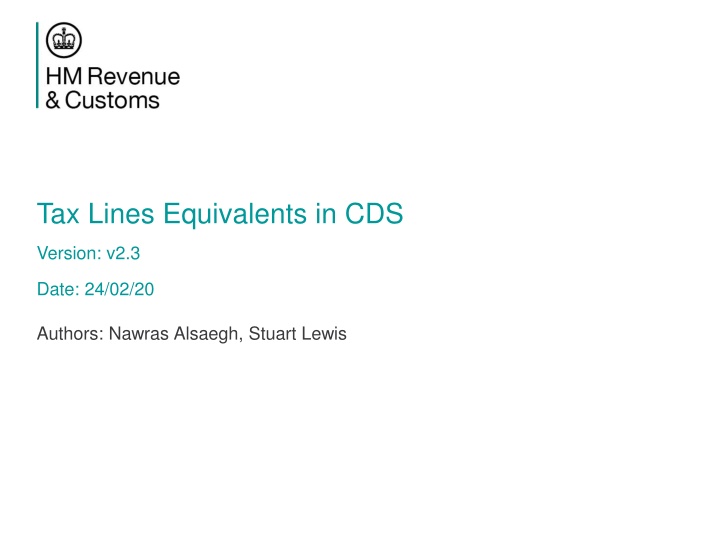



![Town of [Town Name] Real Estate Tax Rates and FY 2024 Budget Summary](/thumb/62211/town-of-town-name-real-estate-tax-rates-and-fy-2024-budget-summary.jpg)



